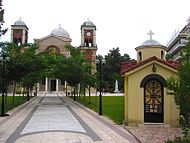Karditsa
Karditsa
Καρδίτσα | |
|---|---|
Settlement | |
 Street in Karditsa | |
| Country | Greece |
| Administrative region | Thessaly |
| Regional unit | Karditsa |
| Government | |
| • Mayor | Dominikos Verillis |
| Area | |
| • Municipal unit | 110.1 km2 (42.5 sq mi) |
| Elevation | 108 m (354 ft) |
| Population (2011)[1] | |
| • Municipal unit | 44,002 |
| • Municipal unit density | 400/km2 (1,000/sq mi) |
| • Community | 39,119 |
| Time zone | UTC+2 (EET) |
| • Summer (DST) | UTC+3 (EEST) |
| Postal code | 431 00 |
| Area code(s) | 24410 |
| Vehicle registration | ΚΑ |
| Website | www.karditsa-city.gr |
Karditsa (Greek: Καρδίτσα) is a city in western Thessaly in mainland Greece. The city of Karditsa is the capital of Karditsa regional unit.
Inhabitation is attested from 9000 BC. Karditsa ls linked with GR-30, the road to Karpenisi, and the road to Palamas and Larissa. Karditsa is south-west of Palamas and Larissa, west of Farsala and the Volos area, north-west of Athens, Lamia, Domokos and Sofades, north of Karpenisi, north-east of Arta, and east-south-east of Trikala, Grevena, Ioannina, and Kalampaka.
Karditsa has schools, lyceums, gymnasium, the Veterinary Medicine Department of the University of Thessaly, three technical education departments, church, banks, a post office, a railway station on the Trikala - Karditsa - Domokos line, a sports ground, a water tower, and squares. Karditsa is one of the most bicycle-friendly cities in Greece with an extensive network of bicycle paths. Approximately 30% of all the city transportation, according to the National Technical University of Athens, is done by bicycles.
History


During the period of Ottoman rule in Thessaly, the main settlement in the location of modern Karditsa was called Sotira,[2] but a village named Kardhítza was mentioned by the English traveler Leake in 1810.[3] Karditsa was incorporated as a new city in 1882, the year after its liberation from the Ottoman Empire.
During World War II, the resistance in Thessaly was fought primarily by the ELAS. Karditsa was the first city in Europe to be liberated from Nazi occupation.[citation needed]
Municipality
The municipality Karditsa was formed at the 2011 local government reform by the merger of the following 5 former municipalities, that became municipal units:[4]
Subdivisions
The municipal unit of Karditsa is divided into six parts (communities):
- Agiopigi
- Artesiano
- Karditsa
- Karditsomagoula
- Palioklissi
- Rousso
Historical population

| Year | Municipal unit | Municipality |
|---|---|---|
| 1981 | 27,532 | - |
| 1991 | 30,067 | - |
| 2001 | 37,768 | - |
| 2011 | 44,002 | 56,747 |
Culture
Sporting Clubs
- Anagennisi Karditsa (Football)
- AO Karditsa (Football)
- Asteras Karditsa (Football)
- SPA Karditsa (Volleyball)
References
- ^ "Απογραφή Πληθυσμού - Κατοικιών 2011. ΜΟΝΙΜΟΣ Πληθυσμός" (in Greek). Hellenic Statistical Authority.
- ^ Arrowsmith, John. Turkey in Europe. 1832.
- ^
Leake, William Martin, FRS (1835). Travels in Northern Greece. Vol. II. London: J. Rodwell. p. 155 et al.
{{cite book}}: CS1 maint: multiple names: authors list (link) - ^ Kallikratis law Greece Ministry of Interior Template:El icon
External links
![]() Media related to Karditsa at Wikimedia Commons
Media related to Karditsa at Wikimedia Commons
- Karditsa Wireless Metropolitan Network, Karditsas Wifi Community Network (in Greek)

